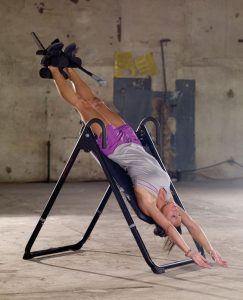November 16, 2020 we had to shut down much of our lives again and fight the invisible enemy that is Covid-19. Many of us will feel like our lives are turned upside down. Perhaps, getting upside down is exactly what we need. Now I like to preface, I am in no way acting as a physician and telling everyone to do what I’m going to be talking about and, of course, always consult your primary physician before doing so, but I wish to share my personal experience.
I’m talking about inversion therapy. It is a modality I have practiced religiously. There is another classic way to achieve the benefits of inversion therapy and I will touch on it later, but what I  practice, and am referring to specifically, is an inversion table. I’m sure many of us have seen those weird table contraptions that hang you by your feet and get you physically upside-down. Costco had a good run of displaying them in-store for awhile. The Teeter inversion table and its varieties are probably the most well-known brand out, and it is the brand I use. A quick Google search of inversion table benefits will grant you a host of benefits, so what I want to speak on are the anecdotal benefits that I feel personally.
practice, and am referring to specifically, is an inversion table. I’m sure many of us have seen those weird table contraptions that hang you by your feet and get you physically upside-down. Costco had a good run of displaying them in-store for awhile. The Teeter inversion table and its varieties are probably the most well-known brand out, and it is the brand I use. A quick Google search of inversion table benefits will grant you a host of benefits, so what I want to speak on are the anecdotal benefits that I feel personally.
One of the purported benefits of inversion tables is that it may make you taller! I could use an inch or two so it didn’t seem like a bad idea for me. After several years of using an inversion table I’m not taller, but I feel my posture has never been better. Standing with a strong, powerful posture provides the confidence boost that we all might need. Moreover, I have never been to a chiropractor and while I am not opposed to seeing one, I just never felt the need or endured a situation that required one. That being said, I’ve noticed I have never had any lingering back issues, particularly lower back when using my inversion table consistently. It would be naïve of me to attribute this solely to the inversion table, but it would be also equally naïve not to at least grant it a bit of credence.
Additionally, while I am in the physical act of hanging upside down, no more than 10 minutes at one time and per day, I feel very, very relaxed. Oft times I use this relaxed state of mind to practice my meditation, and this alone has helped my mental health tremendously. Getting the head and brain “below the heart” is often sited as a wonderful benefit that we could all use. Which leads me to the other way we can achieve inversion therapy without an inversion table. Downward facing dog is a classic posture that gets the head and brain “below the heart.” Supplying our brain with fresh oxygen from the heart, and providing clarity of thought and relaxation. Practicing down dog and accompanying with a routine of yoga postures and stretches provides all the same host of benefits that an inversion table may provide. Better posture, less pain, less stress, and etc. So while gyms are closed and many of us may not have access to equipment, stretching and yoga are some things we can do with just our body and hopefully keep us sane during this current shutdown.
~Jonathan

Leave a Reply